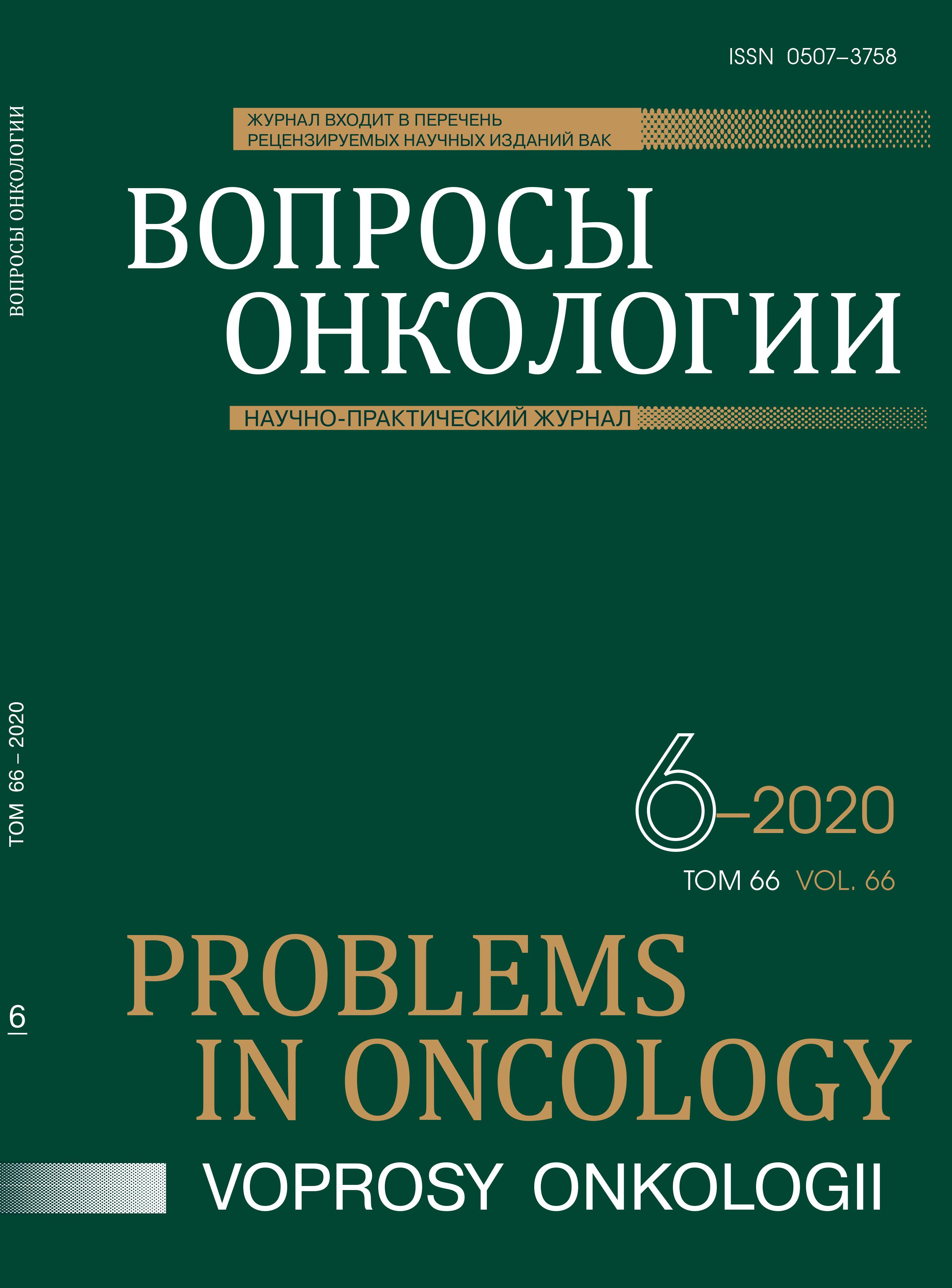Abstract
Introduction. Transformed cells are selectively vulnerable to a deficiency of certain amino acids. L-Lysine α-oxidase (LO) catalyzes the oxidative deamination of L-lysine, resulting in lysine depletion and hydrogen peroxide production. In preclinical models with intravenous and intraperitoneal administration LO shows a wide spectrum of antitumor activity. The purpose of this study was to determine the antitumor effect of orally administered to mice LO under tolerance control. Materials and methods. LO efficiency was studied on models Ca755 and SW620 when administered orally, evaluated using adequate criteria and the method of variation statistics and statistically significant differences at p≤0.05. Results. The antitumor activity and tolerance of LO from Trichoderma cf. aureoviride Rifai BKM F-4268D when administered orally was studied for the first time on murine and human tumor models. It was shown that LO in total doses of 6000-8000 U/kg (discrete mode of administration) reliably and significantly inhibits the growth of mouse breast adenocarcinoma Ca755, Tumor Growth Inhibition, TGImax=80-89% (p<0.05) (criterion of TGI≥50%). A smaller, but reliable effect was obtained on SW620 human colon cancer xenografts at a total dose of 6000 U/kg, T/C=75% (p<0.05) (criterion of T/C≤42%). By oral administration LO did not cause any side effects or death of mice from toxicity in the range of studied doses. Conclusion. This study makes it possible to consider LO promising for preclinical study with oral administration.
References
Amano M., Mizuguchi H., Sano T. et al. Recombinant expression, molecular characterization and crystal structure of antitumor enzyme, L-lysine α-oxidase from Trichoderma viride. The Journal of Biochemistry. 2015;157(6):549-559. https://doi.org/10.1093/jb/mvv012.
Arinbasarova A.Y, Ashin, V.V., Makrushin, K.V. et al. Isolation and properties of L-lysine-α-oxidase from the fungus trichoderma cf. aureoviride RIFAI VKM F-4268D. Microbiology. 2012;81(5): 549-554. https://doi.org/10.1134/S0026261712050037.
Лукашева Е.В., Березов Т.Т. L-лизин-α-оксидаза: физико-химические и биологические свойства. Биохимия. 2002;67(10):1394–1402 [Lukasheva E.V., Berezov T.T. L-lysine-α-oхidase: physico-chemical and biological properties. Biohimija. 2002;67(10):1394—1402 (In Russ.)].
Kitani Y., Kikuchi N., Zhang G. et al. Antibacterial action of L-amino acid oxidase from the skin mucus of rockfish Sebastes schlegelii. Comparative Biochemistry and Physiology Part B: Biochemistry and Molecular Biology. 2008;149(2):394-400. https://doi.org/10.1016/j.cbpb.2007.10.013.
Yang C.A., Cheng C.H., Liu S.Y. et al. Identification of antibacterial mechanism of l‐amino acid oxidase derived from Trichoderma harzianum ETS 323. The FEBS journal. 2011;278(18):3381-3394. https://doi.org/10.1111/j.1742-4658.2011.08262.x.
Pokrovsky V.S, Treshalina H.M., Lukasheva E.V. et al. Enzymatic properties and anticancer activity of L-lysine α-oxidase from Trichoderma cf. aureoviride Rifai BKMF-4268D. Anti-cancer drugs. 2013;24(8):846-851. https://doi.org/10.1097 / CAD.0b013e328362fbe.
Treshalina H.M., Lukasheva E.V., Sedakova L.A. et al. Anticancer enzyme L-lysine α-oxidase. Applied biochemistry and biotechnology. 2000;88(1):267-273. https://doi.org/10.1385/ABAB:88:1-3:267.
Покровский В.С., Трещалина Е.М, Лукашева Е.В. и др. Разработка режима внутривенного введения L-лизин-альфа-оксидазы из Trichoderma cf. aureoviride Rifai BKMF-4268 под контролем переносимости и эффективности лечения. Российский онкологический журнал. 2013;2:10-14 [Pokrovsky V.S., Treshalina E.M., Lukasheva E.V. et al. Development of intravenous administration of L-lysine-alpha-oxidase from Trichoderma cf. aureoviride rifai BKMF-4268 regime controlled by safety and efficacy of treatment. Rossiiskii onkologicheskii zhurnal. (Russian Journal of Oncology). 2013;2:10–14. (In Russ.)].
Бабаева Г., Лукашева Е. В., Черкасова Ж. Р. и др. Возможность интернализации пероральной L-лизин-a-оксидазы в модели изолированного отрезка тонкой кишки крысы. Вопросы онкологии. 2019; 65(3):463-466 [Babayeva G., Lukasheva E.V., Tcherkassova J.R. et al. Possibility of orally administered l-lysine-α-oxidase internalization in the model of isolated cut of rat small intestine. Voprosy onkologii (Problems in oncology). 2019; 65(3): 463-466 (In Russ.)].
Трещалина Е.М., Черкасова Ж.Р., Андронова Н.В. и др. Моделирование интернализации водорастворимых противоопухолевых цитостатиков в тонкой кишке экспресс-методом ex vivo с помощью хемилюминесценции. Сибирский онкологический журнал. 2019;18(6):75–81. https://doi.org/10.21294/1814-4861-2019-18-6-75-81 [Тreshalina H.М., Tcherkassova J.R., Andronova N.V. i dr. Modeling of ex vivo internalization method of water-soluble anticancer drugs in small intestine using chemiluminescence. Siberian Journal of Oncology. 2019; 18(6): 75–81 (In Russ.)].
Руководство по проведению доклинических исследований лекарственных средств (иммунобиологические лекарственные препараты). Часть вторая / под ред. А.Н.Миронова. — М.: Гриф иК, 2012: 966 [Rukovodstvo po provedeniyu doklinicheskikh issledovaniy lekarstvennykh sredstv (immunologicheskiye lekarstvennyye preparaty). Chast vtoraya/pod red. A.N. Mironova – M: Grif iK, 2012:966 (In Russ.)].
Kiela P.R., Ghishan F.K. Physiology of intestinal absorption and secretion. // Best practice & research Clinical gastroenterology. 2016;30(2):145-159. https://doi.org/10.1016/j.bpg.2016.02.007.
Bruno B.J., Miller G.D., Lim C.S. Basics and recent advances in peptide and protein drug delivery. Therapeutic delivery. 2013;4(11):1443-1467. https://doi.org/10.4155/tde.13.104.
Cloutier M., Gingras D., Bendayan M. Internalization and transcytosis of pancreatic enzymes by the intestinal mucosa. Journal of Histochemistry & Cytochemistry. 2006;54(7):781-794. https://doi.org/10.1369/jhc.5A6877.2006.
Ziv E., Bendayan M. Intestinal absorption of peptides through the enterocytes. Microscopy research and technique. 2000;49(4):346-352. https://doi.org/10.1002/(SICI)1097-0029(20000515)49:4<346::AID-JEMT3>3.0.CO;2-B.

This work is licensed under a Creative Commons Attribution-NonCommercial-NoDerivatives 4.0 International License.
© АННМО «Вопросы онкологии», Copyright (c) 2020

